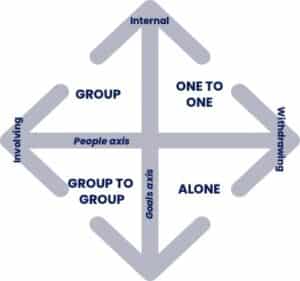
Leadership Mindset Shift #5: One Size Doesn’t Fit All
Share viaIn the quest for efficiency, many organizations attempt to standardize their processes and procedures. While this can be helpful for some things, it can be highly detrimental and demotivating if applied to work environments. The Covid pandemic has accelerated the movement towards remote and hybrid work settings and revealed just how important work environments are to a person’s wellbeing and productivity.
If you surveyed the leaders in your organization, how would they answer these questions?
Have you ever;
- Noticed that some people enjoy meetings, while others check out or withdraw
- Experienced low engagement in a virtual meeting?
- Noticed that people naturally gravitate towards certain environments at work?
- Noticed that people tend to personalize their work space when given the chance?
- Wondered why some people love a group environment full of interactions, while others prefer to work alone without distractions?
Whether working remotely, onsite with others, traveling for work, or a hybrid of all three, effective leaders find or adapt environments to maximize their wellbeing and performance while helping others do the same.
How much choice and control do your employees have over their work environment? Are your leaders creating environments that help different types of people function at their best?
Shifting your leadership mindset about the work environment can make all the difference. Here is the fifth of eight mindset shifts that can transform a leader’s effectiveness.
Leadership Mindset Shift #5
One size doesn’t fit all.
Kay Sargent is pioneering the field of neurodiverse-friendly design. Along with her colleagues at HOK, they are learning just how big an impact the build environment has on people’s well-being and performance.
“We are all different. We have to stop assuming that everyone is just like me. We need to empower individuals to help them find the spaces where they can thrive.” – Kay Sargent
Kay recommends that companies examine HR policies and procedures that allow personal adjustments for a tailored environment. Why? Because on average, 80% of a company’s revenue goes to its people. She argues, “If we do anything in the built environment that negatively impacts people’s ability to function at a higher level, we are costing that company a ton of money.”
Environmental Preferences and Personality
Personality is a type of neurodiversity since it strongly impacts how a person processes and responds to the world around them. The Process Communication Model®, a behavioral model of communication, provides a helpful framework for recognizing and adapting environments for different personality types.
The PCM Assessing Matrix

Some people are internally motivated towards goals. They look inside themselves for guidance on what’s important and what to do next. Responsibility is where they shine.
Some people are externally motivated towards goals. They are activated by responding to the world around them. Responsiveness is where they shine.
Some people are more involving with others, preferring a social setting where they can interact. Building connection is where they shine.
Some people are more withdrawing, preferring less interaction with others. Imagination is where they shine.
When you look at the intersection of Goals and People, there are four distinct quadrants, each representing an environmental preference.
![]()
Groups
People who are internally motivated and involving, prefer group settings. They get energy from social interactions and are motivated to build and nurture relationships. They want to work in safe, supportive environment with plenty of opportunities for interacting with the people they like.
One-On-One
People who are internally motivated and withdrawing prefer one-on-one settings. They get energy from focused interactions around ideas, values, and concepts. They do their best work in an environment with less distractions and more time and space to concentrate and ideate.
Group-To-Group
People who are externally motivated and involving also like to be around others, but for a different reason. They feed off the energy around them, so they naturally gravitate to where the fun and action are. They do their best work in environments that are dynamic, creative, full of stimulation, exciting and fun.
Alone
People who are externally motivated and withdrawing prefer to be alone. They need time and space to reflect, and are energized by solitude. The want direction in the form of tasks and concepts to work on, but prefer to do the work by themselves.
To take advantage of the power of environmental preferences and avoid the trap of one size fits all, consider these three questions:
- Do your employees have options of where and how they work?
- Do your employees have choices of where and how they work?
- Do your employees have control over where and how they work?
The more options, choices and control you can give your employees, the more they can find environments to match their preferences. This is particularly relevant as organizations struggle with return to work conversations while also seeking to attract and retain top talent.
Allow for Different Environmental Preferences To Attract And Retain Top Talent
Imagine the possibilities if you made allowances for different environmental preferences. How could you conduct virtual meetings differently? What about return to work conversations? When designing physicial workplaces, how could you build in more options, choices and control for employees?
Here’s a great article on Designing a Neurodiverse Workplace
“If you leave anyone out of the mix, you don’t have inclusion. You have distortion.”
– Olivet Jones
Shift Your Mindset To Become A Better Leader
Learning how to recognize and adapt to the environmental preferences of different personality types is the focus of one of the modules in the PCM Leadership Program.
In this module, leaders will learn how to:
- Create personality-inclusive work environments.
- Improve your employees’ wellbeing and performance.
- Improve the effectiveness of meetings and other gatherings.
Contact us today to find out more about how PCM helps leaders recognize and maximize the critical intersection between communication and personality.
Why Choose the PCM Leadership Program?
People skills are the primary leadership differentiator: being able to connect, engage, resolve conflict with and motivate anyone are essential leadership skills. Today’s leaders must cultivate their self-awareness and agility to be successful in a highly diverse, global and virtual environment.
The PCM Leadership Program is a collection of learning & application modules that apply the Process Communication Model to solve the most common and important leadership challenges.
Senior leaders will gain a greater understanding of how their own personality impacts their role and performance as a leader, how to adapt communication and motivation strategies to maximize the contribution of all personality types in the workplace, and how personality differences are best managed from a strategic level.
Newly promoted and mid-level leaders will learn and apply critical social-emotional and communication competencies to improve their effectiveness in a wide range of leadership challenges such as communicating for greater impact, managing and motivating performance, dealing with miscommunication and conflict, building trust and engagement, and self-care.
Copyright Next Element Consulting, LLC 2023
Boost Your Leadership Self-Awareness
Book Your Next Keynote Speaker

Author and Co-founder of Next Element, Dr. Nate Regier is available to speak at your upcoming event.
Submit a Speaker RequestPodcast: Listen to Nate "On Compassion"
 Listen to the Podcast
Listen to the Podcast



0 Comments
Add comment